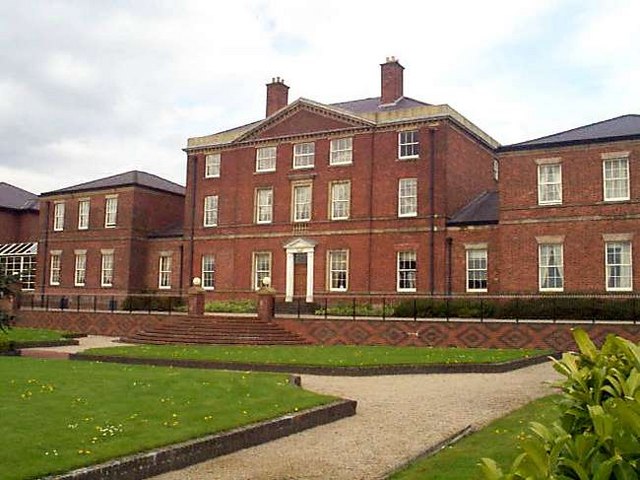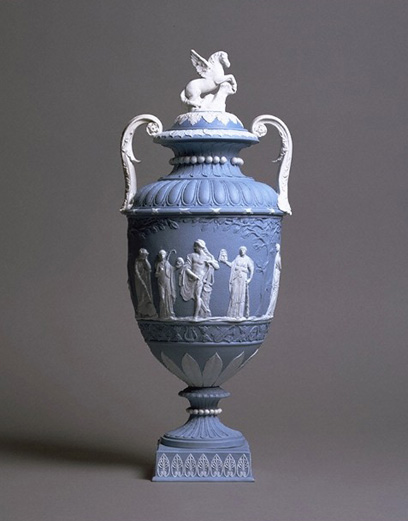|
Wedgwood
Wedgwood is an English China (material), fine china, porcelain and luxury accessories manufacturer that was founded on 1 May 1759 by the potter and entrepreneur Josiah Wedgwood and was first incorporated in 1895 as Josiah Wedgwood and Sons Ltd. It was rapidly successful and was soon one of the largest manufacturers of Staffordshire pottery, "a firm that has done more to spread the knowledge and enhance the reputation of British ceramic art than any other manufacturer", exporting across Europe as far as Russia, and to the Americas. It was especially successful at producing fine earthenware and stoneware that, though considerably less expensive, were accepted as equivalent in quality to porcelain (which Wedgwood made only later). Wedgwood is especially associated with the "dry-bodied" (unglazed) stoneware Jasperware in contrasting colours, and in particular that in "Wedgwood blue" and white, always much the most popular colours, though there are several others. Jasperware ha ... [...More Info...] [...Related Items...] OR: [Wikipedia] [Google] [Baidu] |
Josiah Wedgwood
Josiah Wedgwood (12 July 1730 – 3 January 1795) was an English potter, entrepreneur and abolitionist. Founding the Wedgwood company in 1759, he developed improved pottery bodies by systematic experimentation, and was the leader in the industrialisation of the manufacture of European pottery. The renewed classical enthusiasms of the late 1760s and early 1770s were of major importance to his sales promotion. His expensive goods were in much demand from the upper classes, while he used emulation effects to market cheaper sets to the rest of society. Every new invention that Wedgwood produced – green glaze, creamware, black basalt, and jasperware – was quickly copied. Having once achieved efficiency in production, he obtained efficiencies in sales and distribution. His showrooms in London gave the public the chance to see his complete range of tableware. Wedgwood's company never made porcelain during his lifetime, but specialised in fine earthenwares and stonewares that ... [...More Info...] [...Related Items...] OR: [Wikipedia] [Google] [Baidu] |
Jasperware
Jasperware, or jasper ware, is a type of pottery first developed by Josiah Wedgwood in the 1770s. Usually described as stoneware, it has an unglazed matte "biscuit" finish and is produced in a number of different colours, of which the most common and best known is a pale blue that has become known as " Wedgwood blue". Relief decorations in contrasting colours (typically in white but also in other colours) are characteristic of jasperware, giving a cameo effect. The reliefs are produced in moulds and applied to the ware as sprigs. After several years of experiments, Wedgwood began to sell jasperware in the late 1770s, at first as small objects, but from the 1780s adding large vases. It was extremely popular, and after a few years many other potters devised their own versions. Wedgwood continues to make it into the 21st century. The decoration was initially in the fashionable Neoclassical style, which was often used in the following centuries, but it could be made to suit oth ... [...More Info...] [...Related Items...] OR: [Wikipedia] [Google] [Baidu] |
Waterford Wedgwood
Waterford Wedgwood plc was an Irish holding company for a group of firms that specialized in the manufacture of high-quality porcelain, bone china and glass products, mostly for use as tableware or home decor. The group was dominated by Irish businessman Tony O'Reilly and his family, including his wife Chryss Goulandris and her family, with the two families together having invested hundreds of millions of euros in it. The group's financial record was mixed, and significant cost-cutting had been ongoing for many years. In 2009, parts of the group, including the main Irish and UK operations, were placed into receivership and acquired by KPS Capital Partners, a New York–based private equity firm. Waterford Crystal and Wedgwood, along with Royal Doulton and other brands, were transferred to a new company named WWRD Holdings Limited (with WWRD as an acronym for 'Waterford Wedgwood Royal Doulton'). In July 2015, WWRD Holdings was acquired by Fiskars, a Finnish consumer goods compan ... [...More Info...] [...Related Items...] OR: [Wikipedia] [Google] [Baidu] |
Thomas Whieldon
Thomas Whieldon (September 1719 in Penkhull, Staffordshire – March 1795) was an English potter who played a leading role in the development of Staffordshire pottery. The attribution of actual pieces to his factory has long been uncertain, and terms such as "Whieldon-type" are now often used for a variety of different types of wares. Other terms reflecting the lack of certainty are "Whieldon ware" as a type, and "Astbury-Whieldon", used for early Staffordshire figures, where the two were pioneers. He worked in earthenware and stoneware, using a variety of types of body and ceramic glazes. He is especially associated with agate ware and tortoiseshell ware; in both cases Whieldon refined the techniques used, and made the types more popular. Personal life Whieldon is first recorded as a potter in 1744 when he married Anne Shaw at Barlaston Church. Little is known about his early career and it is not known where he served his apprenticeship. Anne died in 1757 and in 1758 W ... [...More Info...] [...Related Items...] OR: [Wikipedia] [Google] [Baidu] |
Stoke-on-Trent
Stoke-on-Trent (often abbreviated to Stoke) is a city and Unitary authorities of England, unitary authority area in Staffordshire, England. It has an estimated population of 259,965 as of 2022, making it the largest settlement in Staffordshire and one of the largest cities of the Midlands. Stoke is surrounded by the towns of Newcastle-under-Lyme, Alsager, Kidsgrove and Biddulph, which form a conurbation around the city. The city is wikt:polycentric, polycentric, formed from Federation of Stoke-on-Trent, the federation of six towns in 1910. It took its name from the town of Stoke-upon-Trent where the main centre of government and the principal Stoke-on-Trent railway station, railway station in the district were located. Hanley is the primary commercial centre. The other four towns which form the city are Burslem, Tunstall, Staffordshire, Tunstall, Longton, Staffordshire, Longton and Fenton, Staffordshire, Fenton. The home of the pottery industry in England, it is known as Staffo ... [...More Info...] [...Related Items...] OR: [Wikipedia] [Google] [Baidu] |
WWRD Holdings Limited
WWRD Holdings Limited is a company that was created by KPS Capital Partners in 2009 out of the remains of Irish firm Waterford Wedgwood plc, and it has been owned since 2015 by Finnish home products maker Fiskars. The company owns Waterford Crystal, Wedgwood and Royal Doulton, among other brands, and the name WWRD is an acronym for 'Waterford Wedgwood Royal Doulton'. History On 5 January 2009, following years of financial problems at the group level, and after a share placement failed during the 2008 financial crisis, Waterford Wedgwood was placed into administration on a "going concern" basis, with 1800 employees remaining. On 27 February 2009, Waterford Wedgwood's receiver, Deloitte, announced that the New York-based private equity firm KPS Capital Partners had purchased "certain Irish and UK assets of Waterford Wedgwood and the assets of several of its Irish and UK subsidiaries" in a transaction expected to be completed in March. In March 2009, KPS Capital Partners announc ... [...More Info...] [...Related Items...] OR: [Wikipedia] [Google] [Baidu] |
Pearlware
Creamware is a cream-coloured refined earthenware with a lead glaze over a pale body, known in France as '' faïence fine'', in the Netherlands as ''Engels porselein'', and in Italy as ''terraglia inglese''.Osborne, 140 It was created about 1750 by the potters of Staffordshire, England, who refined the materials and techniques of salt-glazed earthenware towards a finer, thinner, whiter body with a brilliant glassy lead glaze, which proved so ideal for domestic ware that it supplanted white salt-glaze wares by about 1780. It was popular until the 1840s. Variations of creamware were known as "tortoiseshell ware" or "Whieldon ware" were developed by the master potter Thomas Whieldon with coloured stains under the glaze. It served as an inexpensive substitute for the soft-paste porcelains being developed by contemporary English manufactories, initially in competition with Chinese export porcelains. It was often made in the same fashionable and refined styles as porcelain. The ... [...More Info...] [...Related Items...] OR: [Wikipedia] [Google] [Baidu] |
Stoneware
Stoneware is a broad class of pottery fired at a relatively high temperature, to be impervious to water. A modern definition is a Vitrification#Ceramics, vitreous or semi-vitreous ceramic made primarily from stoneware clay or non-refractory fire clay.Arthur Dodd & David Murfin. ''Dictionary of Ceramics''; 3rd edition. The Institute of Minerals, 1994. This definition excludes stone vessels that are carving, carved from a solid chunk of rock (geology), stone. End applications of stoneware include tableware and ceramic art, decorative ware such as vases. Stoneware is fired at between about to . Historically, reaching such temperatures was a long-lasting challenge, and temperatures somewhat below these were used for a long time. It was developed independently in different locations around the world, after earthenware and before porcelain. Stoneware is not recognised as a category in traditional East Asian terminology, and much Asian stoneware, such as Chinese Ding ware for exampl ... [...More Info...] [...Related Items...] OR: [Wikipedia] [Google] [Baidu] |
Waterford Crystal
Waterford Crystal is an Irish manufacturer of crystal glassware, especially cut glass products. It is named after the city of Waterford in Ireland. In January 2009, the main Waterford Crystal manufacturing base on the edge of Waterford was closed due to the insolvency of Waterford Wedgwood plc, and in June 2010, Waterford Crystal relocated almost back to the roots of glass-making in the city centre. The Mall location holds both a manufacturing facility that melts over 750 tonnes of crystal a year – although most Waterford Crystal is now produced outside Ireland – and a visitor centre with the world's largest collection of Waterford Crystal. Since 2015, the brand has been owned by Fiskars Corporation. History Waterford Glassworks The origins of crystal production in Waterford date back to 1783, when George Penrose and his nephew William Penrose started their business, the Waterford Glassworks. It produced extremely fine flint glass that became world-renowned. That firm ... [...More Info...] [...Related Items...] OR: [Wikipedia] [Google] [Baidu] |
Burslem
Burslem ( ) is one of the six towns that along with Hanley, Staffordshire, Hanley, Tunstall, Staffordshire, Tunstall, Fenton, Staffordshire, Fenton, Longton, Staffordshire, Longton and Stoke-upon-Trent form part of the city of Stoke-on-Trent in Staffordshire, England. It is often referred to as the "mother town" of Stoke on Trent. The population of the town was included under the Burslem Central ward and had a population of 6,490 in the 2021 Census. Topography Burslem is on the eastern ridge of the Fowlea Valley, the Fowlea being one of the main early tributaries of the River Trent. Burslem embraces the areas of Middleport, Staffordshire, Middleport, Dalehall, Longport, Westport, Trubshaw Cross, and Brownhills. The Trent & Mersey Canal cuts through, to the west and south of the town centre. A little further west, the West Coast Main Line railway and the A500 road run in parallel, forming a distinct boundary between Burslem and the abutting town of Newcastle-under-Lyme. To the so ... [...More Info...] [...Related Items...] OR: [Wikipedia] [Google] [Baidu] |







